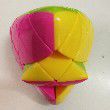
дёҖйҒ“з®—жі•йўҳпјҢиҰҒжұӮз”Ёc++еҶҷ
иҰҒжұӮз”ЁйҒ—дј з®—жі•жҲ–иҖ…е…¶д»–йқһжҡҙеҠӣз®—жі•и§ЈгҖӮжұӮи§ЈеҮҪж•°f(x)=x+10*sin(5*x)+7*cos(4*x)еңЁеҢәй—ҙ[0,9]зҡ„жңҖеӨ§еҖјгҖӮиҰҒжұӮз»“жһңдҝқз•ҷеҲ°е°Ҹж•°зӮ№еҗҺ6дҪҚ...
иҰҒжұӮз”ЁйҒ—дј з®—жі•жҲ–иҖ…е…¶д»–йқһжҡҙеҠӣз®—жі•и§ЈгҖӮжұӮи§ЈеҮҪж•° f(x) = x + 10*sin(5*x) + 7*cos(4*x) еңЁеҢәй—ҙ[0,9]зҡ„жңҖеӨ§еҖјгҖӮиҰҒжұӮз»“жһңдҝқз•ҷеҲ°е°Ҹж•°зӮ№еҗҺ6дҪҚ
еұ•ејҖ
2018-09-18 В· зҹҘйҒ“еҗҲдјҷдәәж•ҷиӮІиЎҢ家
 ејҲиҪ©
ејҲиҪ©
зҹҘйҒ“еҗҲдјҷдәәж•ҷиӮІиЎҢ家
йҮҮзәіж•°пјҡ1029
иҺ·иөһж•°пјҡ7542
з”өеӯҗи®ҫи®ЎеӨ§иөӣдёүзӯүеҘ– дјҳз§ҖжҜ•дёҡз”ҹ
еҗ‘TAжҸҗй—® з§ҒдҝЎTA
е…іжіЁ
![]()

еұ•ејҖе…ЁйғЁ
еҰӮеӣҫ
дёҖејҖе§Ӣе°ұжңүзӮ№еңЁжңҖеҖјйҷ„иҝ‘дәҶпјҢдҪҶжҳҜиҝҳжңүвҖңж®ӢдҪҷеҠҝеҠӣвҖқеңЁиҝңзҰ»жңҖеҖјзҡ„ең°ж–№гҖӮ
жңҖеҗҺиҜҜе·®еұ…然ж¶ҲйҷӨдәҶпјҒжҖ»е…ұиҖ—ж—¶дёҚеҲ°1sгҖӮ
з”ұдәҺд»Јз ҒиҝҮй•ҝпјҢеҸӘеұ•зӨәдёҖйғЁеҲҶпјҢжҸҗдҫӣжҖқи·ҜпјҢе…·дҪ“д»Јз ҒиҜ·з§ҒиҒҠеҸ‘пјҡ
typedef unsigned int UINT32;
typedef unsigned short UINT16;
#define FOR_ITER(iter,object) for (auto (iter) = (object).begin(); (iter) != (object).end(); (iter)++)
class Random {
private:
static bool init;
public:
Random() {
if (!init) {
srand((int)time(0)); init= true;
}
} //еҲқе§ӢеҢ–йҡҸжңәж•°з§Қеӯҗ
// static int rand() { return rand(); }
static double rand_df(const double &a=0, const double &b=1);
static UINT32 randUINT();
};
bool Random::init = false;
double Random::rand_df(const double & a, const double & b) {
return a + (b - a)*rand() / RAND_MAX;
}
UINT32 Random::randUINT(){
return UINT32(((rand() % 0x10000) << 16) | (rand() % 0x10000));
}
class GrayCode {
private:
static bool init;
static unsigned char gray2bi[512]; //жҹҘиЎЁжі•ж јйӣ·з ҒиҪ¬дәҢиҝӣеҲ¶(0~255)第9дҪҚжҳҜиҝӣдҪҚж Үеҝ—
public:
GrayCode() {
if (!init)
for (UINT32 bi = 0; bi < 512; bi++)
gray2bi[toGray(bi)] = bi%256;
}
//дәҢиҝӣеҲ¶иҪ¬ж јйӣ·з Ғ
static UINT32 toGray(const UINT32 & bi) {
return bi ^ (bi >> 1);
}
//ж јйӣ·з ҒиҪ¬дәҢиҝӣеҲ¶вҳ…(йҡҫ)
static UINT32 toBi(const UINT32 &gray) {
int shift = 24;
UINT32 bi=0;
while (true) { //д»Һgrayй«ҳдҪҚеҲ°дҪҺдҪҚиҪ¬жҚў
bi |= gray2bi[ //biзҡ„жңҖдҪҺдҪҚдҪңдёәжҹҘиЎЁзҡ„иҝӣдҪҚж Үеҝ—
(bi | ((gray >> shift) & 0xff))%512];
if(shift>0){
bi <<= 8; shift -= 8;
}else break;
}
return bi;
}
//иҫ“еҮәдёәдәҢиҝӣеҲ¶еӯ—з¬ҰгҖӮ
static void printBi(const int &num) {
for (UINT32 p = 0x80000000,count=8; p != 0; p >>= 1){
if (num&p) putchar('1');
else putchar('0');
if (--count == 0) {
putchar(' '); count = 8;
}
}
}
};
bool GrayCode::init = false;
unsigned char GrayCode::gray2bi[512];
//йҒ—дј з®—жі• жұӮжңҖеҖј
class Individuality:Random, GrayCode {
private:
static UINT32 mutation_factor[32]; //зӘҒеҸҳеӣ еӯҗ {1,2,4,8,16,...}
static bool init;
UINT32 gene; //еҹәеӣ (ж јйӣ·з Ғ)
UINT32 transgenation_2(); //еҹәеӣ зӘҒеҸҳпјҲйқһеқҮеҢҖпјҢжҡӮж—¶ејғз”Ёпјү
//жұӮи§ЈеҮҪж•°еҖј
double f() {
double x = get_x();
return x + 10 * sin(5 * x) + 7 * cos(4 * x);//вҳ…з”ЁжҲ·иҮӘе®ҡд№үпјҢжұӮи§Јзҡ„еҮҪж•° гҖӮ
}
double y; //yеҖјпјҲз”ҹжҲҗgene马дёҠи®Ўз®—пјү
public:
Individuality();
Individuality(const UINT32 &gene) :gene(gene),y(f()) {}
Individuality(const Individuality &a, const Individuality &b); //дәӨеҸүз№Ғж®–дә§з”ҹеҗҺд»Ј
Individuality transgenation(); //еқҮеҢҖеҹәеӣ зӘҒеҸҳ1дҪҚ
double get_y() { return y; }
double adaptability; //йў„з•ҷз»ҷз”ЁжҲ·иҮӘе®ҡд№ү
//gene(ж јйӣ·з ҒиҰҒе…ҲиҪ¬дәҢиҝӣеҲ¶)жҳ е°„еҲ°еҢәй—ҙ[0,9]зҡ„ж•°
double get_x() {
return (double)toBi(gene) * ((double)9 / 0xffffffff);
}
static bool cmp_y(const Individuality &a, const Individuality &b) {
return a.y < b.y;
}
};
bool Individuality::init = false;
UINT32 Individuality::mutation_factor[32];
typedef vector<Individuality>::iterator Idv_Iter;
class Natrue {
private:
vector<Individuality> idvs; //дёӘдҪ“йӣҶеҗҲ
int generation=0; //д»Ј 0дёәеҲқд»Ј
int max_num; // max_numГ·num-1дёәз№Ғж®–зҺҮ
int num; // жҜҸдёҖд»ЈжҖ»зҫӨж•°йҮҸжҺ§еҲ¶
//йҖӮеә”еәҰеҮҪж•°пјҲйЎ»е…·дҪ“й—®йўҳе…·дҪ“е®ҡд№үпјүпјҢйқһиҙҹеҚіеҸҜпјҢеҸҜд»ҘдёҚеҪ’дёҖеҢ–пјҢеҖјдёә0д»ЈиЎЁеҝ…иў«ж·ҳжұ°
void calculate_adaptability();
int statistics_generation = -1;
double error;
pair<Idv_Iter, Idv_Iter> min_max_idv;
//зәҝзЁӢдёҺе®үе…Ё
bool wooking = false;
Natrue(); //зҰҒз”Ёй»ҳи®Өжһ„йҖ
public:
//еҲқе§ӢеҢ–дә§з”ҹnumдёӘйҡҸжңәдёӘдҪ“
Natrue(int num,int max_num):num(num), max_num(max_num){
idvs.reserve(max_num);
idvs.resize(num); //з”Ёй»ҳи®Өжһ„йҖ numдёӘгҖӮ
}
//йҡҸжңәдәӨеҸүз№Ғж®–пјҲеҹәеӣ зӘҒеҸҳжҰӮзҺҮпјүпјӣ
void reproduce(double GM_Probability);
//иҪ®зӣҳиөҢйҖүжӢ©
void roulette_wheel_selection();
//з»ҹи®Ўз»“жһң
void statistics_y(double &min_y);
// void statistics_y(Individuality *&min_y, Individuality *&max_y);
double& get_error();
const Idv_Iter get_max_idv();
int get_generation() {return generation;}
};
int main()
{
Natrue s(50,100);
for (int i = 100; i > 0;i--){
s.reproduce(0.3);
s.roulette_wheel_selection();
printf("第%d代\n", s.get_generation());
printf("error=%e\t", s.get_error());
printf("x=%lf\ty= %lf\n", s.get_max_idv()->get_x(),s.get_max_idv()->get_y() );
}
system("pause");
return 0;
}
жҺЁиҚҗеҫӢеёҲжңҚеҠЎпјҡ
иӢҘжңӘи§ЈеҶіжӮЁзҡ„й—®йўҳпјҢиҜ·жӮЁиҜҰз»ҶжҸҸиҝ°жӮЁзҡ„й—®йўҳпјҢйҖҡиҝҮзҷҫеәҰеҫӢдёҙиҝӣиЎҢе…Қиҙ№дё“дёҡе’ЁиҜў
|
е№ҝе‘Ҡ жӮЁеҸҜиғҪе…іжіЁзҡ„еҶ…е®№ |




